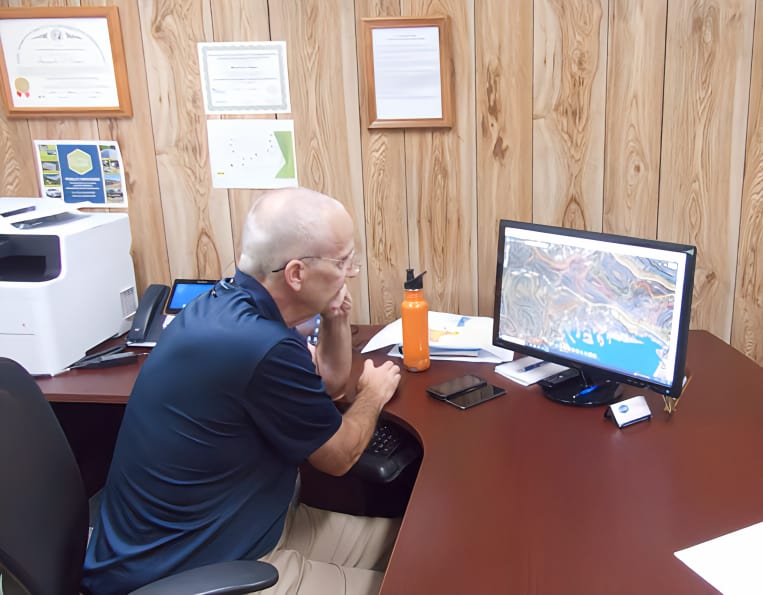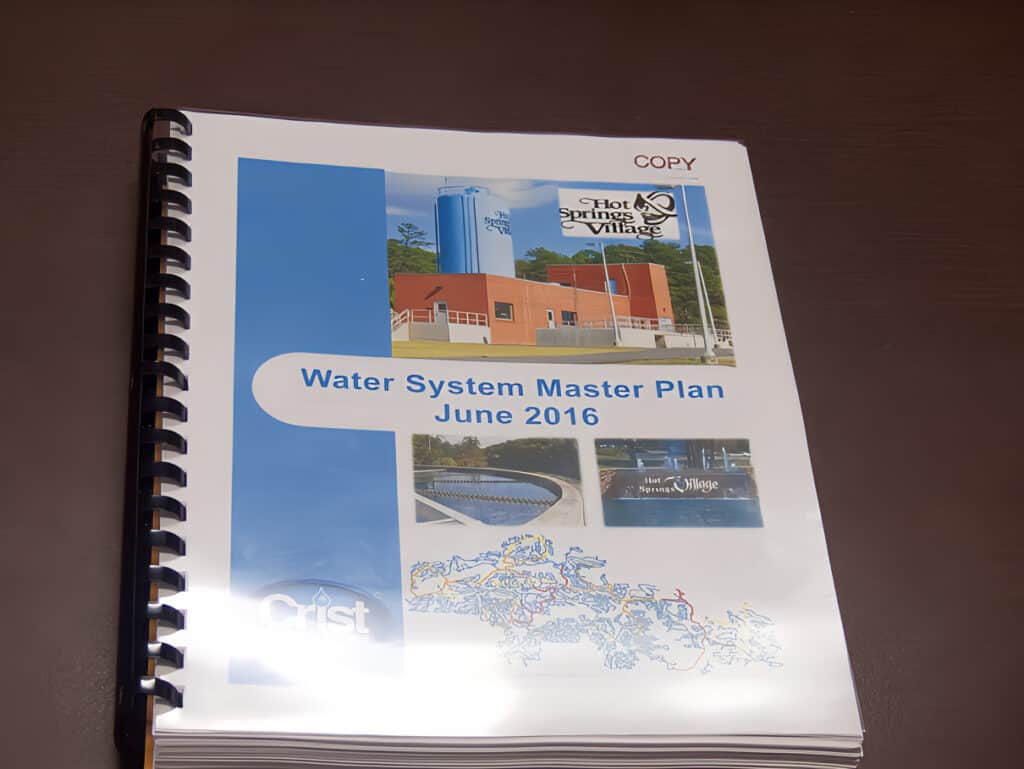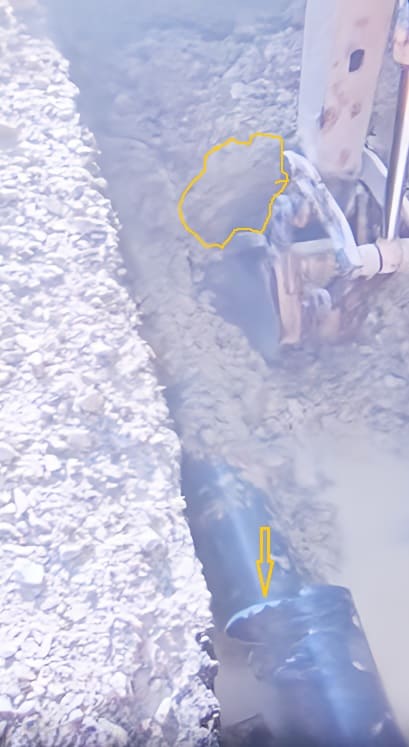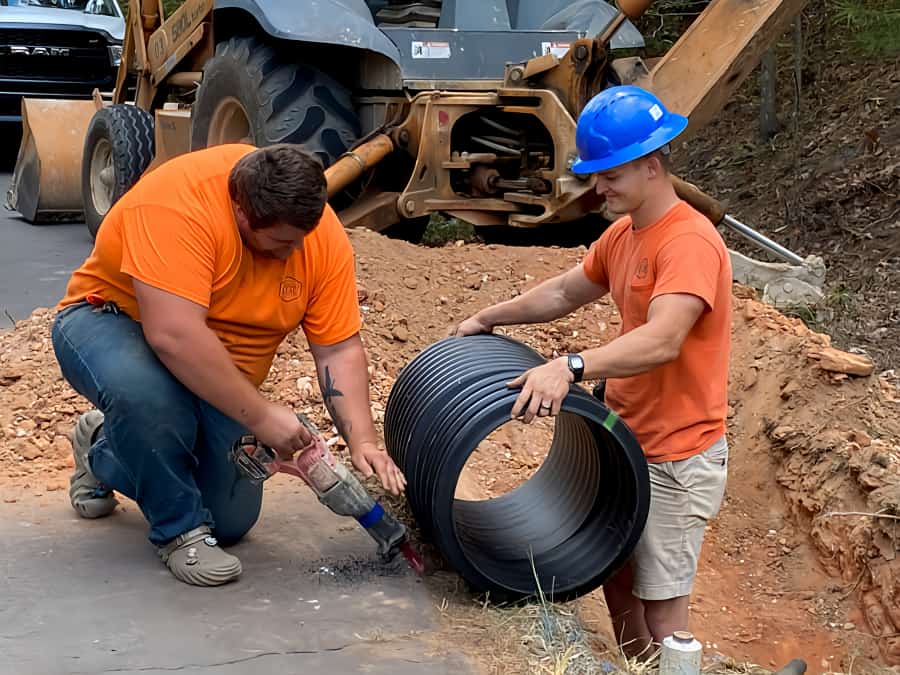In this article, Hot Springs Village POA Public Services Director Ken Unger discusses the reality of Hot Springs Village water mains. The Director talks about the good, the bad, and the ugly, including why frequent breaks occur and his plans to address the issues and improve the system. The good news is that problems in the water main system are being addressed. The bad news is the water main breaks cause a lot of inconvenience for staff and Villagers, and much work needs to be done. Now for the ugly – this work does not come cheaply.
Unger’s First Year as Public Services Director Was Spent Evaluating the Wastewater System
“I spent the first year evaluating sewer. I think we have a pretty good handle on that aspect…I just contracted with Crist Engineering to update our 2016 water study. The 2016 study was not fully vetted to the engineers. It was not based on a full system analysis,” stated Unger. As Unger continues to evaluate the HSV water system, he will not only have a grasp on what is needed but will determine the cost of the needed work.

Difficulty in Locating Water Mains

HSV Gazette stated, “Recently, Hot Springs Village experienced water main pipe bursts on September 18 and 19, affecting approximately 1,600 to 1,700 homes and 600 [actually, this was closer to 650] homes, respectively. To his knowledge, Ken Unger, Director of Public Services, said in the history of the Village, these water outages were the largest the Village has had to contend with.”
Unger shared that two September 18 and 19 outages resulted from “the POA’s inability to locate water mains properly.” Unger said he is accustomed to water mains being constructed out of iron pipe, allowing for easier locating. According to eHow, “With a metal detector, you should be able to locate cast iron pipes buried up to eight feet underground.”
The Public Services Director explained, “When you install PVC mains or use other materials, normally a tracer wire is installed so that when you use a metal detector, you can trace the line location. You can’t locate the water mains in the Village using a metal detector because tracer wires were not installed in the water line system.” (Tracer wire is being installed in replacement water main projects.)

Hot Springs Village Water Mains are Composed of Various Materials
“Pipes made of multiple materials were used in the past, including Perma-Strand, ACP (Asbestos Cement Pipe), and PVC (polyvinyl chloride). There may be a few more that I am not aware of at this point. But they used various materials in the past, depending on what was available,” stated Unger.
“We replaced a section of Perma-Strand pipe on Viajero Drive that was leaking. Perma-Strand is used in oil pipelines and not typically used in water systems. It is an interesting pipe because it can deal with pressures coming out but not with compression from the outside. We have to use sleeves when installing a clamp so as not to crush the pipe. We have three miles of Perma-Strand that we need to replace,” the Public Services Director said.
What Caused Two September Pipe Bursts?
Two of the recent large breaks in September were what Unger calls “self-inflicted wounds.” Two breaks occurred at locations where Public Services was installing guard rails. Unger said they are looking at different guardrail installation procedures so the workers will not need to dig as deep. Unger frankly shared, “We probably should have done this, to begin with, instead of driving casings down. I did not understand that we were unable to locate the water lines. I learned a lesson. We even dug to try to identify the location of the water lines, and we still didn’t properly identify the water line locations. We have a very difficult time locating pipes, and we are going to have to avoid doing things on top of water mains,”
Valve Failures Causing Expanded Outages
Unger continued, “But this is not what made the recent September main breaks affect so many homes. Issues with the system valves are what caused a larger water outage. We do not have the valves in the system fully mapped or tested.”
Previously, the HSV Gazette stated that Unger’s “department is methodically going through the system and testing [and mapping] the valves. The number of valves in the system is unknown, but there are thousands…Repairing or replacing malfunctioning valves will help reduce the size of water outages. Currently, Alena McCoy, Supervisor in the Public Services Department, is working to map the whole system accurately.”
At one of the September breaks, the POA attempted to close a valve to isolate the effect of the break, but it was determined the valve was inoperable.
We had to shut off an entire 14″ water main. The 14″ water main is the single feed to one of our major tanks. Due to the main burst, we discovered the 14″ valve failure. This valve did not fail at this time. It has been inoperable for “a long time. Nobody fixed it.
Ken Unger, Hot Springs Village POA Public Services Director
When asked if the POA knew the valve was inoperable, Unger responded:
The general answer is ‘yes.’ They were just not investing in repairing the water system. We have a lot of issues to fix, and this is just one example. This 14″ main water valve was not working and had not been working for a long time. We knew about this. If the valve had been functioning, the number of homes affected by the outage would have been fewer.
Ken Unger, Hot Springs Village POA Public Services Director
Note: Unger is not saying he had advance knowledge of the inoperable valve, but that others were aware.
Lack of Redundant Paths in Water Main System
“We also lack redundant paths in our water main system, ” stated Unger. Unger explained that the best analogy he could use would be to compare the Hot Springs Village water main system to branches growing from a tree. “As the Village grew from west to east, the water lines were installed like tree branches. There is not a lot of looping, which provides better redundancy in the system.”
We have opportunities to provide system redundancy. This year, the Public Services Director took advantage of two looping opportunities on the Carmona and Barcelona projects. “While replacing water mains, redundant paths were installed.”
Previously, HSV Gazette reported, “We will be looking at installing more diverse water supply lines [also referred to as redundant paths], which will help improve the water system’s reliability. This is not line replacement, but the addition of lines to provide diverse paths for water to get into neighborhoods.” Doing this will improve the water supply reliability in case of a main break.
Unger stated that in 2024, he will focus on installing redundant paths in the waterline system. “The needed diverse routes are not necessarily long but must be done.”
“At least three redundant paths need to be installed next year.” Unger estimated installing the redundant paths would cost approximately $200,000.
Terrain in Village Leads to Various Pressure Zones
“There are different pressure zones because of the Village terrain and severe elevation changes. All of the zones are not necessarily connected because of the pressure difference. When they are connected, it is with certain types of valves that control the pressure. One of these valves is called a pressure-reducing valve. One of the reasons the second outage in September was so impactful is that there was a diverse path for water to be routed into the area, but the pressure-reducing valve faced the opposite direction, and that restricted water from back-flowing into the lines. In other words, this pressure-reducing valve could not reverse flow.” There was not a bypass on this pressure-reducing valve. Unger said about 650 homes were affected by the second September water outage.
Unger said, “We must go through the system and locate the pressure-reducing valves. It is known that some of the pressure-reducing valves are not working. The pressure-reducing valves cause a restriction of water flow, yet they are not reducing the pressure.”
“We removed the pressure-reducing valve that caused the second September outage to provide redundancy in the system. We are monitoring the area to see if there is anything else we need to do,” explained Unger.
“We have fairly high pressures in most of our system in many spots due to the elevation changes. We also have a few low-pressure areas. Unger said, “Pressure is a two-edged sword. You want good pressure but don’t want too high of pressure. We fixed a few areas this year where the pressure was too high (over 220 psi). 220 psi is way too high.”
Unger said they are trying to eliminate the areas where the pressure is over 150 psi. Unger said he does not know how many areas there are with water pressure that is too high. “We are still evaluating that,” said Unger.
The takeaway from the valve situation is that correction will result in 2024 water outages as the department works to make the needed repairs.
Vibration of Water Pipes Against Adjacent Boulders Can Cause Water Pipe Bursts
Unger said, “We have a lot of main breaks that occur in the early mornings.” There is a phenomenon called water-hammer. Water hammer can occur in any piping system where valves control the water flow. The water hammer results from an abrupt pressure surge through the piping system.
When digging up water mains for repair, the department sometimes discovers large rocks [boulders] lying against the water lines. Below is an image from the Minorca repair.

“Water hammer occurs when you introduce force into a water main. Sprinklers often start around 4:00 a.m., resulting in a surge in water demand. A lot of water is not used during the night, but all of a sudden, early in the morning, the demand increases. This causes a rush of water flow in the system. The pumps kick on, which causes an additional rush of water through the system, and you start getting vibrations in the lines. When you have lines bedded next to rock, you get breaks,” explained the Director. The pipe in the Minorca break was made of Perma-Strand. As mentioned above, Perma-Strand pipes do not handle outside pressure very well. So when you couple the boulder laying next to the water main and the increased pressure in the lines due to the water hammer causing the pipe to vibrate against the boulder, you have a pipe burst ‘just waiting to happen.’
Unger explained, “Keeping water moving steadily will avoid water hammer issues. Instead of pumps shutting down and kicking on, you keep a pump running constantly to keep water circulating through the system. We are trialing a new method some of our peers used to keep the water plant operating at a steady state, whenever possible, and looking at how fast we ramp up and down the pumps to minimize the vibration occurring in the system.”

“The water hammer effect is directly attributable to changes in the system that result from pump activity. We’ve instituted some changes on the table and will know better in the weeks ahead if the changes are helping. I believe they will. This is one of the things we are doing to minimize breaks. As the lines are older, and when they are next to boulders, any line movement can cause a rupture.”
The goal is to minimize any impact to the system to avoid the breaks.
Ken Unger, Hot Springs Village POA Public Services Director
2024 Focus on Valve Work Will Cause Water Outages
“The valve issue is unknown to me right now. We have thousands of valves and don’t have time to exercise [test] all of them. We will focus some of our money next year on replacing some of the major valves. Replacing inoperable valves will cause outages because of the location of the valves.” Inoperable valves are causing water outages to impact more homes.
As Unger works to replace inoperable valves and install redundant water main paths, the scope of future water outages due to main bursts should be reduced. If the valves are working properly and there are redundant paths to provide water into areas from other directions, outages would not affect as many homes. Unger said that is part of what we are targeting – how to back feed water delivery into the areas within the same pressure zones and locate critical, non-working valves. Unger hopes to use automated voice messaging to notify Villagers before the work occurs.
Conservation of Water and Inverted Block Rate Structure Could Delay Water Plant Upgrade
While Unger explained the scope of the needed water main work, he also mentioned the possible adoption of an inverted block rate structure and conservation of water usage. Doing these two things could delay the need to upgrade the water plant.
We have a rate structure that does not discourage the indiscriminate use of water. We cannot continue to promote the indiscriminate use of water. If we have to upgrade the water plant again, from six (6) to eight (8) million gallons per day, think of the implication on the distribution system. A plant upgrade of that size now would cost approximately $10 M.* Promoting water usage for only a few months out of the year is driving a need to upgrade. This is not wise in my opinion. We need the community to realize that. I just had Charlie [Brown] go to the ACC and tell them that we need to start talking about drought-tolerant plants and landscaping. We don’t want to enforce this as a requirement. We want to promote the conservation of water. We don’t want irrigation needs to drive the necessity of another water plant upgrade.
Ken Unger, Hot Springs Village POA Public Services Director
Video Showing 2022 Water Main Burst
While the video below is not from the recent waterline breaks, it will give you an idea of what a pipe burst looks like. Having experienced multiple water main bursts on our street, we documented this break and the subsequent repair by Hot Springs Village staff. (Video credit to Joe Dowden)
The featured image is illustrative, depicting a 2022 water main break.
*The $10 M figure to upgrade the water plant from 6 to 8 million gallons per day does not include needed main upgrades.
By Cheryl Dowden
Contact Information for HSV Public Services Director
Ken Unger
Director Public Services
Hot Springs Village
501-226-9609
Kunger@hsvpoa.org
We’d love to have you join our private Property Owners’ Facebook Group. Click here to join.
Click here to visit the Hot Springs Village POA Official Facebook Page.



Ms. Dowden, thank you for making this very helpful information available to us. Mr. Unger, thank you for your diligent work. And thank you for making your comments in easily understandable English.
Many thanks to you Cheryl and Ken for explaining the history, facts and present realities about our water infrastructure challenges. The expression OUT OF SIGHT, OUT OF MIND, keeps coming to mind.
Thank you, John. – Cheryl
According to asbestos.com “The Environmental Protection Agency, under the Safe Drinking Water Act of 1974, has set a maximum contaminant level of 7 million fibers per liter. This level was determined to be an acceptable level of protection to prevent health issues, based on the best available science.” That sounds like a lot of asbestos fibers to be acceptable in roughly a quart of water. (When such water evaporates, seems like those asbestos fibers could become airborne.)
Thank you Cheryl for this very informative article and thank you Ken Unger for getting after this very necessary project. Thankfully, the assessment increase passed to provide funding for this.
Thank you for commenting, Johnny. ACT 605, passed on April 5, 2021, provides greater oversight on Arkansas water providers, and in some cases covers waste treatment providers, also. HSV’s water and waste treatment plants are operated as a joint and single undertaking and fall under a single audit, so they both fall under ACT 605. Both sewer and water expenses, including day-to-day operations, repairs, improvements, bonds, reserves, etc. must be paid for by money collected from the utility bills. ACT 605 requires a rate study to be done so that the utility company (in this case the POA) charges the amount needed to cover these expenses. ACT 605 came about because some smaller water service providers “got into trouble.” Here is a link to my article about ACT 605 How Will ACT 605 Affect Hot Springs Village Utilities?. I imagine the POA will look at bonding to pay needed water and/or sewer upgrades, but the bonding will be paid for out of money collected on the utility bills. Thanks again for commenting.
Coming from Phoenix, and also a volunteer fire fighter on 42, every year we had a certain number of fire hydrants ensure water flow. Now with three years resident; should “cracking” the fire hydrants be done in HSV?